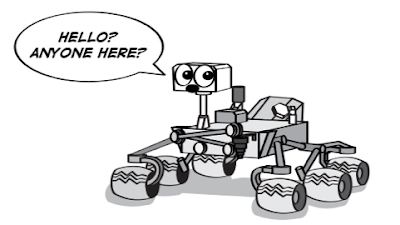PVL is running a rover mission control simulation at the Ontario Science Center on July 28th and 29th. Everyone is invited to come, visit and participate as we explore a mystery planet! For more information, over to Dr. Christina Smith.
(Image taken from: https://spaceplace.nasa.gov/mars-curiosity/en/ )
(Image taken from: https://spaceplace.nasa.gov/mars-curiosity/en/ )
by Dr. Christina L. Smith
You may (or may not) have noticed
that Mars is looking a little brighter than usual at the moment. And from July
27th-30th it will actually be the brightest it has been
since 2003! Mars is currently approaching opposition where the Sun, the Earth,
and Mars are all in alignment. This happens roughly every 26 months and this
one will happen on July 27th. Closely related to this is the closest
approach of Mars to Earth – this time it happens four days later on July 31st.
To celebrate Mars’ proximity and opposition, a number of events are happening
around Toronto (and beyond) this week to let you observe and learn about Mars
and just generally bask in the glory of The Red Planet’s awesomeness.
As part of this, some members of
the Planetary Volatiles Laboratory are putting on an event at the Ontario Science Centre this coming weekend (July 28th and 29th)
called the Rover Exploration Challenge. This is a drop in event where
participants can experience what it’s like to be part of a team trying to
explore another planet. They’ll be divided up into three science groups, each
of whom have a different set of science goals to achieve in a limited amount of
Rover Science Time. Every Rover Day, lasting about half an hour, a different
team will come in and will be given a Mission Briefing to show them what kind
of science they can do. Afterwards, Science Leads will take them through
everything we know so far relating to their science goals – what we know, what
we don’t know, what they can do to help complete the mission.
The first decision the Mission
Team will need to make is whether they want the rover to drive. Each drive allows
the rover to explore a new area, but the rover can’t go back to explore a place
it’s already been so they have to make sure they have done everything they
might want to do before moving on!
Different Science Groups have different goals, which may influence
whether or not they want to drive and in this team, democracy rules so if the
majority says a drive is “Go!” then that’s what will happen. So if one group
needs to stay put or needs to drive, they need to persuade the other science
teams that that’s what they should vote for.
After the drive decision, the
different Science Groups need to decide what they want to study and when during
the Rover Day. There’s atmospheric measurements, water tests, ground tests, and
imaging available to take with the rover, and different sites could be very
different from one another so it’s important to test these at different
locations along the Rover’s Exploration Path. After they’ve decided what they
want the rover to do and put it into the Rover Plan, it’s time to check the
plan, upload it to the rover, and wait for the results to come back. But
there’s always an element of risk when using the rover: observations could
fail, drives could fault, or the whole rover could shut down...

No comments:
Post a Comment